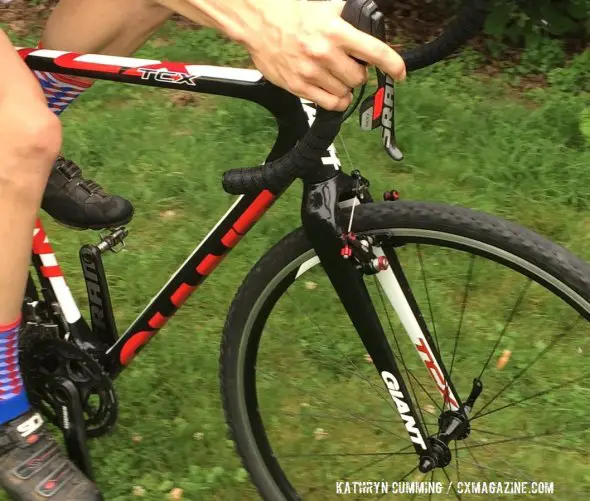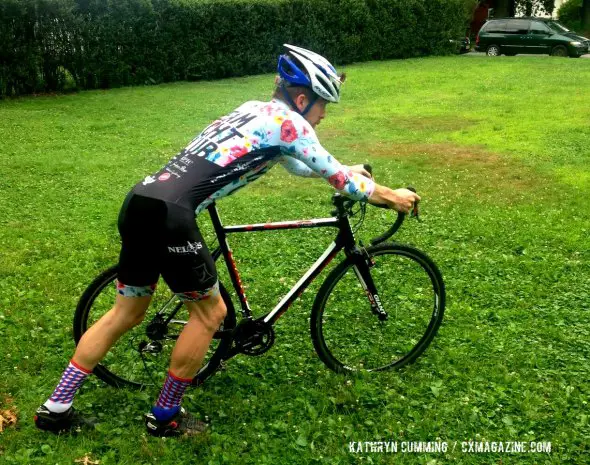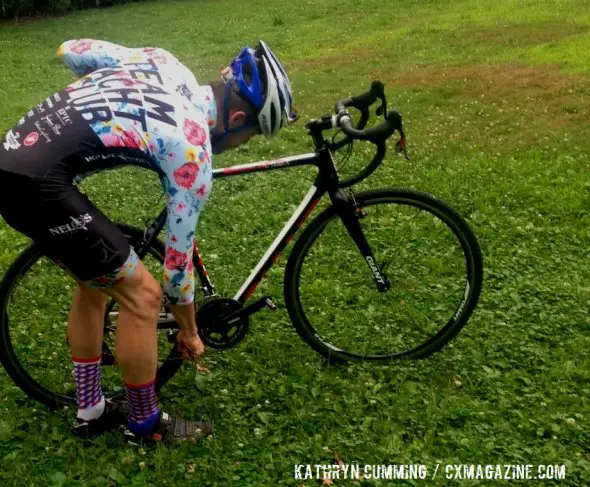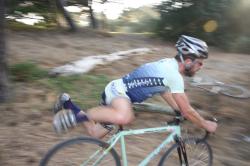If dropped chains are constantly ruining your races, you might want to stay tuned for an upcoming Mechanical Monday to help you prevent this disaster. If you’re looking how to quickly repair a dropped chain in the middle of a cyclocross race, you’ve come to the right place.
Several years ago, on a rainy night in early September, my wife and I rode up to a small park in Harlem, close on the wheel of a man named Zoltan Tisza. Zoltan is a staple of New York cycling, not only is he a well-known coach, but his titles include the Hungarian National Champion as well as a participant in two Elite Men’s races in the Cyclocross World Championships. For the next few hours, he was going to unlock some of his secrets to both of us.
We started with some of the basics: proper mounts without stutter-steps and bike handling while a leg has already swung over the seat. Then we stopped for twenty minutes to practice something I would have never expected: training to deal with a dropped chain. Looking back now, I realize it was one of the best things I learned that night.
I’ve seen plenty of racers, even those in the elite categories, struggling with their chains as they stand next to the race tape, letting time to bleed away while they are caught in a standstill. One of the more memorable events was Kevin Pauwels’s disastrous chain drop during the 2013 Cyclocross World Championships, which goes to show you that even racers with the best mechanics and fine-tuned machines can’t prevent a mechanical mishap every now and again.
There is a time and a place when a rider will be forced to stop and manually put their chain on by hand, and Pauwels’s mechanical was likely one of those situations, but it certainly shouldn’t occur every time a chain is dropped.
So on the stage anniversary when Andy Schleck dropped his chain, costing him the yellow jersey in the Tour de France, I bring you tips on how to deal with a dangling chain without losing twenty places in the process.
Requirements:
In order to correct a chain that has either dropped inward or outward while still maintaining forward progress, you will need a front derailleur. Although dropping your chain is far less likely on a singlespeed or other drivetrains with single chainrings, like SRAM’s CX1, if you somehow manage to drop your chain, pulling off to the side and reattaching the chain by hand will be your only option.
If you’re more concerned with prevention than reaction, stay tuned for a future Mechanical Monday where we will address the mechanical concerns of chain dropping. While outer and inner chain guards help prevent dropping your chain (a single chainring with two guards is an ideal setup), even perfectly tuned bikes are not immune to the chaos of cyclocross racing.
When practicing, I usually like to take a stick with me so I don’t have to get my hands dirty when I intentionally drop my chain. Just press the stick against your chain where it meets the bottom of your chainring then sweep upwards; towards you if you want to simulate a chain dropping outward, and away from you in you want to simulate a chain dropping inward. If you’re like me, you’ll want to simulate both methods until you are thoroughly comfortable handling both during race day.
The Process:
You will only need a small field with a sizable running space to practice reattaching the chain with your front derailleur. No matter which way the chain dropped, the first thing you will need is speed, and plenty of it. Firmly grab a hold both of your hoods and sprint forward with your eyes on the path ahead of you.
As you are running forward, use your left hand to shift your front derailleur to the appropriate chainring. If your chain dropped outward, you will want to set the derailleur to the lower gear. In the more likely case that your chain dropped inward, you’ll want to shift to the larger chainring. Such shifting might sound counter-intuitive, but the idea here is to use your front derailluer cage to dramatically pull the chain back to a usable position.
Next, leap forward onto your saddle as if you were remounting normally. Remember: eyes ahead of you, not down on your pedals.

Low-torque, soft pedaling takes a much larger priority than quickly clipping into your pedals. © Kathryn Cumming
When your chain is dropped, you get no extra points for clipping in quickly and blasting off. In fact, if you put too much force on your pedals at this moment in the process, there’s a chance that you will twist or break your chain or derailleur. The goal is pedaling softly until your chain is back on a chainring and you are able to happily mash your pedals until you cross the finish line. Again, think low-torque, light pedal strokes. If you feel a sudden resistance when the chain is climbing on the teeth, back the rotation off slightly and try once again.
If you’ve lost all your speed and still haven’t been able to connect the chain, don’t keep forcing the situation. Dismount and sprint back up to speed. It is the speed you gain by running which allows you to pedal with low force. Attempting to shift a chain back into gear from a standstill requires tremendous power, which is not a good mixture when your chain is in such a precarious position.

Running dirty side or clean, the idea is to gain as much speed as you can while your feet are still on the ground. Always look at the road ahead. A view of a sagging chain will only dishearten you. © Kathryn Cumming
This is not something that takes years to master. Once you are able to shift the chain from a dropped position, you’ll discover that the technique will begin to feel like second nature.





























